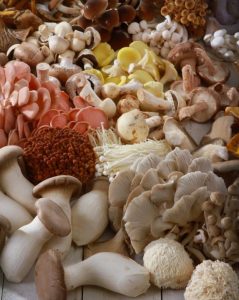Spring is upon us! While you’re taking care of spring cleaning for your home, it’s also the perfect time to clean out your kitchen.
Take a look in your freezer, fridge, and pantry to see what you have left from fall and winter meals.
Does your fridge drawer have a few forgotten veggies hanging around?
Do you have frozen squash, kale, peppers, mashed potatoes, green cubes, or other veggies in your freezer?
Maybe some frozen soups or stews? Do you have frozen proteins on hand – beef, chicken, or fish? Take a quick inventory and let’s get cooking!
If you sometimes find a few sad, straggling veggies in the back of your fridge (oops!), you are not alone.
But they don’t have to go to waste – give your forgotten winter veggies a spring makeover!
Use this formula to Ferment Any Vegetable in Brine and extend the life of your beets, carrots, radishes, and more. Keep the formula handy and use all year long.
Try this formula for how to build a complete grain bowl. Grain bowls are a perfect way to create a balanced and satisfying meal and use ingredients you already have in your kitchen. Click here for the recipe!
You can also try this easy Cream of Any Vegetable Soup Formula to use up fresh or frozen veggies to make a quick, nourishing meal. Serve with sourdough bread and a side salad.
Cream of Any Vegetable Soup
Formula:
- Vegetable Base (Frozen or Fresh) – 3 to 4 cups
- 💡Tip: Use a couple of potatoes in your vegetable base. Save time by keeping skins on.
- Aromatics – Onion, garlic, leeks, or shallots
- Liquid – 4 cups broth (chicken, vegetable, or water)
- Creamy Element – Fromage blanc, heavy cream, coconut milk, or blended white beans
- Seasoning & Extras – Salt, pepper, herbs, chili flakes, nuts/seeds for garnish
Method:
- Sauté aromatics in oil or butter.
- Add frozen or fresh vegetables and broth. Simmer until tender (about 15 minutes).
- Blend until smooth, then stir in the creamy element. Adjust seasoning.
- Serve with toppings like toasted nuts, seeds, or herbs.
Suggestions:
- Creamy Butternut Squash Soup – Frozen squash, leeks, thyme, fromage blanc.
- Broccoli-Cauliflower Soup – Frozen broccoli & cauliflower, garlic, nutmeg, and sunflower seeds on top.
- Carrot-Ginger Soup – Frozen carrots, fresh ginger, coconut milk, and chili flakes.
MEAL IDEAS FOR YOUR LOCAL ORGANIC FOOD THIS WEEK:
Many of these recipes include produce or other items you may have received in your market box. You may also see ingredients you can purchase at the WHF General Store. Experiment and see what you can use to create your meal plan!
💡Pro tip: Always check your recipes to see what you have and what you need to purchase. Takes a few extra minutes in planning, but it beats finding out at the last minute that you’re missing ingredients!
FEATURED:
Try any of these easy meal ideas. These are basic guidelines and can be adapted to your preferences and ingredient availability.
Have fun – and please share your creations in the Telegram group chat!
Hearty Skillet Hash
- Sauté frozen root veggies (squash, sweet potatoes, parsnips) with ground beef or sausage.
- 💡Tip: Swap ground beef/sausage for shredded chicken or flaked salmon.
- Add onions, garlic, and spices (smoked paprika, chili flakes).
- Stir in chopped dried apricots, cranberries, or raisins for a hint of sweetness.
- Sprinkle with toasted walnuts, pecans, or sunflower seeds for crunch.
- Serve with a dollop of fromage blanc for creamy contrast.
Rustic Shepherd’s Pie
- Brown ground beef or sausage with frozen mirepoix (onion, celery, carrot).
- 💡Tip: Use shredded chicken instead of beef, or mix in flaked salmon.
- Add broth, Worcestershire sauce, and frozen peas, green beans, or spinach.
- Stir in chopped dried figs or dates for richness.
- Spread mashed potatoes or pureed squash mixed with fromage blanc on top.
- Sprinkle pumpkin seeds or crushed nuts before baking.
Cozy Vegetable & Meat Soup
- Brown ground beef or sausage, then add broth, tomatoes, and frozen veggies (cabbage, kale, mixed root vegetables).
- 💡Tip: Pureed squash could work here in place of tomatoes.
- 💡Tip: Swap sausage/beef for shredded or cubed chicken.
- Stir in dried cherries or golden raisins for depth of flavor.
- Garnish with toasted nuts or seeds for crunch.
- Swirl in fromage blanc or coconut milk before serving for creaminess.
Stuffed Peppers or Squash
- Mix cooked ground, shredded, or cubed meat with frozen rice or grains, frozen spinach, and cheese.
- Stir in dried cranberries or chopped apricots for a sweet-savory contrast.
- Add chopped almonds or sunflower seeds for texture.
- Stuff into thawed bell peppers or halved acorn squash, then bake.
- Sprinkle more cheese on top or serve with fromage blanc as a topping or side.
Savory Casserole
- Combine ground meat (or diced chicken or salmon), frozen veggies (like cauliflower, broccoli, Brussels sprouts), and cooked pasta or rice.
- Stir in dried figs or raisins for texture and depth.
- Bind with eggs and cheese.
- 💡Tip: Use fromage blanc instead of some of the cheese for a richer, creamier texture.
- Top with toasted nuts or seeds before baking.
Quick Stir-Fry or Fried Rice
- Sauté frozen veggies (broccoli, carrots, bell peppers) with ground sausage or beef.
- 💡Tip: Chicken or salmon could work for protein as well.
- Toss in chopped dried pineapple or mango for a sweet balance.
- Stir in cooked rice or grains, soy sauce, and spices (garlic and ginger for .
- Garnish with sesame seeds or crushed cashews.
Stuffed Baked Sweet Potatoes
- Bake frozen potatoes or use hash browns.
- Top with ground sausage, frozen spinach, and cheese.
- 💡Tip: Try chicken or salmon, too.
- Stir in dried cherries or figs for a sweet-savory balance.
- Sprinkle with toasted walnuts or pepitas.
- Finish with a spoonful of fromage blanc or sour cream.
Freezer Clean-Out Crock Pot Chili
- Brown ground beef or sausage, then add:
- Frozen veggies (butternut squash, bell peppers, carrots, corn)
- Beans (kidney, black, or pinto)
- Tomatoes (crushed & diced), tomato paste, broth
- Chili powder, cumin, smoked paprika, garlic powder
- 💡Tip: Use shredded or diced chicken in place of beef/sausage.
- Stir in chopped dried dates, apricots, or golden raisins in the last hour for depth.
- Garnish with toasted sunflower seeds or crushed almonds.
- Swirl in fromage blanc or sour cream before serving for a creamy finish.
BREAD:
- Our farm-made Country Sunflower sourdough bread is just the thing to complete a meal.
- If your sweet tooth needs attention, definitely try our maple bourbon sourdough cinnamon roll or some peanut butter chocolate chip cookies (made by the farm girls).
DAIRY:
- Fromage blanc or feta cheese adds a bit of something creamy and tangy to your salads and other dishes.
- Add a fried egg to any hash or grain bowl for an extra protein boost – or simply choose that as your main protein.
- Remember to add nutrient-rich raw milk, yogurt, or kefir to your market box order.
- 💡Tip: Yogurt and kefir are probiotic powerhouses.
- 💡Tip: Creamy yogurt-based dressing is a delicious option for your salads and grain bowls.
MEAT:
- Ground beef & sausage are easy to combine with other ingredients to make a complete meal.
- Chicken is also a great base for quick meals, especially if you happen to have some already-cooked leftovers.
- Have you tried our cured pork bacon? It’s perfect for breakfast, but save a few slices to crumble over salads, bowls, or soups for lunch/dinner. We also have turkey bacon available if you’re looking for a slightly different flavor twist.
PANTRY RECOMMENDATIONS:
- Nuts, seeds, and dried fruits are all good options for adding flavor and texture to your salads, grain bowls, and other meals. We have plenty of options to choose from!
- We have oils and vinegars, and tahini that you can use to make delicious sauces/dressings for your meals.
FRUIT:
Storage for all apple varieties:
Keep unwashed apples in a plastic bag in the refrigerator’s crisper drawer, where they can stay fresh for up to two weeks.
 Apple, Crimson Crisp – This variety is known for its deep red skin, crisp texture, and balanced sweet-tart flavor. Crimson Crisp apples are an excellent source of dietary fiber and vitamin C. They also contain antioxidants that contribute to overall health. These medium-sized apples are perfect for fresh snacking, adding to salads, or using in baking due to their firm texture. Their balanced flavor makes them ideal for making applesauce, cider, or pies. Pair slices with cheese or nut butter for a delicious snack.
Apple, Crimson Crisp – This variety is known for its deep red skin, crisp texture, and balanced sweet-tart flavor. Crimson Crisp apples are an excellent source of dietary fiber and vitamin C. They also contain antioxidants that contribute to overall health. These medium-sized apples are perfect for fresh snacking, adding to salads, or using in baking due to their firm texture. Their balanced flavor makes them ideal for making applesauce, cider, or pies. Pair slices with cheese or nut butter for a delicious snack.
 Apples, Golden Delicious – Golden Delicious apples are a versatile variety with a sweet, mellow flavor and a crisp yet tender texture. They are high in fiber, vitamin C, and antioxidants, which support digestion, immune health, and skin health. These apples retain their shape and flavor, making them excellent for eating fresh, baking pies, making sauces, or adding to salads.
Apples, Golden Delicious – Golden Delicious apples are a versatile variety with a sweet, mellow flavor and a crisp yet tender texture. They are high in fiber, vitamin C, and antioxidants, which support digestion, immune health, and skin health. These apples retain their shape and flavor, making them excellent for eating fresh, baking pies, making sauces, or adding to salads.
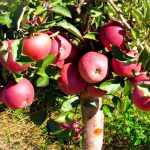 Apples, Pink Lady – Pink Lady apples are a crisp, juicy apple variety with a balanced sweet-tart flavor and a vibrant pinkish-red skin. They are high in fiber, vitamin C, and antioxidants, promoting heart health, immune support, and skin health. Pink Lady apples hold their shape well so they are great for snacking, adding to salads, or baking.
Apples, Pink Lady – Pink Lady apples are a crisp, juicy apple variety with a balanced sweet-tart flavor and a vibrant pinkish-red skin. They are high in fiber, vitamin C, and antioxidants, promoting heart health, immune support, and skin health. Pink Lady apples hold their shape well so they are great for snacking, adding to salads, or baking.
 Grapefruit – Grapefruit is a citrus fruit known for its juicy, tangy-sweet flavor with a slight bitterness. It is rich in vitamin C, fiber, and antioxidants like lycopene, promoting immune health, heart health, and skin health. Grapefruit can be eaten fresh, added to salads, or juiced for a refreshing drink. Store whole grapefruit at room temperature for up to a week or in the refrigerator for up to three weeks.
Grapefruit – Grapefruit is a citrus fruit known for its juicy, tangy-sweet flavor with a slight bitterness. It is rich in vitamin C, fiber, and antioxidants like lycopene, promoting immune health, heart health, and skin health. Grapefruit can be eaten fresh, added to salads, or juiced for a refreshing drink. Store whole grapefruit at room temperature for up to a week or in the refrigerator for up to three weeks.

Lemon – Lemons are tangy citrus fruits packed with vitamin C, antioxidants, and citric acid, which aid digestion, boost immunity, and enhance skin health. They are commonly used to add flavor to beverages, marinades, dressings, and desserts or as a natural cleaning agent. Store lemons at room temperature if using them soon or refrigerate them in a perforated bag to extend their shelf life up to 3-4 weeks.
 Orange, Mandarin – These small, sweet citrus fruits have a thin, easy-to-peel skin. They are high in vitamin C, fiber, and flavonoids, supporting immune function, digestion, and heart health. Mandarins are perfect for snacking, adding to desserts, or tossing into salads. Store them at room temperature for a few days or refrigerate to extend freshness for up to two weeks.
Orange, Mandarin – These small, sweet citrus fruits have a thin, easy-to-peel skin. They are high in vitamin C, fiber, and flavonoids, supporting immune function, digestion, and heart health. Mandarins are perfect for snacking, adding to desserts, or tossing into salads. Store them at room temperature for a few days or refrigerate to extend freshness for up to two weeks.
 Orange, Navel – Navel oranges are sweet, seedless, and easy to peel, making them an excellent snack or addition to salads and desserts. They are high in vitamin C, fiber, and antioxidants, which promote immune health and support heart health. Store navel oranges at room temperature for up to a week or refrigerate them in a mesh bag for up to three weeks to maintain freshness. Wash before peeling or slicing.
Orange, Navel – Navel oranges are sweet, seedless, and easy to peel, making them an excellent snack or addition to salads and desserts. They are high in vitamin C, fiber, and antioxidants, which promote immune health and support heart health. Store navel oranges at room temperature for up to a week or refrigerate them in a mesh bag for up to three weeks to maintain freshness. Wash before peeling or slicing.
Organic Veggies We Harvested This Week:
To help you use everything in your box this week, use this Meal Planning Guide to keep track of what’s in the fridge, what needs to be used first, and what you have planned or prepped for each day.
Every member’s customized Market Box is unique so we hope you will take advantage of more varieties of vegetables as you get comfortable with all the great organic produce we are offering.
Tessa’s Tips
What to use first: greens, mushrooms, green onions
Longest Storage: apples, beets, carrots, potatoes
Pro-tip: Look at the items in your market box right away and decide how you will use them in your meal planning for the week. Freeze any veggies you know you won’t be able to eat in the week.

Arugula – This leafy green has a peppery, slightly bitter flavor and is commonly used in salads, sandwiches, and as a garnish. It is low in calories and packed with vitamins A, C, and K, as well as folate and antioxidants, which support eye health, immune function, and bone strength. Arugula can be eaten fresh or lightly wilted in pasta dishes and pizzas. Some prefer to eat it tossed with other fresh greens or lettuce so that the spicy taste is not as strong. Putting it on a sandwich is another delicious way to enjoy its distinct flavor. Store wrapped in a paper towel inside a loosely sealed plastic bag in the refrigerator crisper drawer. Properly stored, arugula can stay fresh for up to 3-5 days. For best quality, use arugula soon after purchasing.
Arugula isn’t just for salad. Here are 29 Ways to Eat Arugula including pasta dishes, pizza, sandwiches, and more.
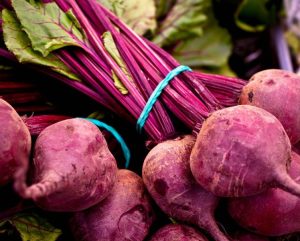 Beet, Red – Red beets are root vegetables known for their earthy flavor and vibrant red-purple color. They are rich in nutrients like folate, manganese, potassium, dietary fiber, and antioxidants such as betalains, which help reduce inflammation and support heart health. Both the roots and greens are edible, with the greens offering additional nutrients like vitamins A and C. Beets can be eaten raw in salads, roasted, boiled, or blended into smoothies and soups. Store beet greens separately from the root, wrapped in a damp cloth or in a plastic bag in the fridge. Use within a few days – they don’t keep long. Beetroots can be stored in a plastic bag in the fridge’s crisper drawer for up to two weeks. To freeze beets for longer storage, slice or chop them, spread on a cookie sheet to flash freeze, then transfer to freezer bags where they can be stored for up to a year.
Beet, Red – Red beets are root vegetables known for their earthy flavor and vibrant red-purple color. They are rich in nutrients like folate, manganese, potassium, dietary fiber, and antioxidants such as betalains, which help reduce inflammation and support heart health. Both the roots and greens are edible, with the greens offering additional nutrients like vitamins A and C. Beets can be eaten raw in salads, roasted, boiled, or blended into smoothies and soups. Store beet greens separately from the root, wrapped in a damp cloth or in a plastic bag in the fridge. Use within a few days – they don’t keep long. Beetroots can be stored in a plastic bag in the fridge’s crisper drawer for up to two weeks. To freeze beets for longer storage, slice or chop them, spread on a cookie sheet to flash freeze, then transfer to freezer bags where they can be stored for up to a year.
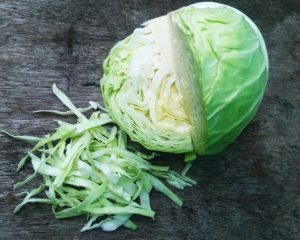 Cabbage, Green – Green cabbage is a nutrient-dense cruciferous vegetable in the Brassica family, known for its tightly packed, round, pale green leaves. It is rich in vitamins C and K, as well as fiber and antioxidants, which are beneficial for immune health, digestion, and bone strength. With a mild, slightly peppery taste, green cabbage can be enjoyed raw in salads and slaws, or cooked in stir-fries, soups, and stews. To store, keep green cabbage unwashed in a perforated plastic bag in the refrigerator’s crisper drawer, where it can stay fresh for up to two weeks.
Cabbage, Green – Green cabbage is a nutrient-dense cruciferous vegetable in the Brassica family, known for its tightly packed, round, pale green leaves. It is rich in vitamins C and K, as well as fiber and antioxidants, which are beneficial for immune health, digestion, and bone strength. With a mild, slightly peppery taste, green cabbage can be enjoyed raw in salads and slaws, or cooked in stir-fries, soups, and stews. To store, keep green cabbage unwashed in a perforated plastic bag in the refrigerator’s crisper drawer, where it can stay fresh for up to two weeks.
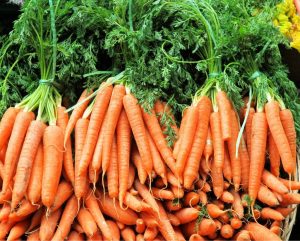 Carrot – Carrots are a versatile and popular root vegetable, known for their sweet, crunchy texture and vibrant orange color, though they can also be found in purple, yellow, and red varieties. They are rich in beta-carotene, which the body converts to vitamin A, essential for good vision and immune health. Carrots are a good source of dietary fiber, potassium, and antioxidants. Enjoy them raw, cooked, roasted, or juiced. They can be used in salads, soups, stews, and side dishes. For optimal storage, store carrots unwashed in the fridge, preferably in a plastic bag or container to maintain moisture, where they can last for several weeks. If the greens are attached, cut them off to prevent the carrots from becoming limp. Stored properly, they should last around 1-2 weeks.
Carrot – Carrots are a versatile and popular root vegetable, known for their sweet, crunchy texture and vibrant orange color, though they can also be found in purple, yellow, and red varieties. They are rich in beta-carotene, which the body converts to vitamin A, essential for good vision and immune health. Carrots are a good source of dietary fiber, potassium, and antioxidants. Enjoy them raw, cooked, roasted, or juiced. They can be used in salads, soups, stews, and side dishes. For optimal storage, store carrots unwashed in the fridge, preferably in a plastic bag or container to maintain moisture, where they can last for several weeks. If the greens are attached, cut them off to prevent the carrots from becoming limp. Stored properly, they should last around 1-2 weeks.

Carrot, Rainbow – In addition to the nutritional benefits above, rainbow carrots stand out from standard orange carrots with their vibrant colors—purple, yellow, red, and white—each offering unique nutritional benefits and distinct flavors. Purple carrots contain anthocyanins, powerful antioxidants linked to anti-inflammatory and heart-health benefits, with a slightly earthy, spicy taste. Yellow carrots are rich in lutein, which promotes eye health by protecting against macular degeneration and cataracts, and they have a mild, subtly sweet flavor. Red carrots contain lycopene, a potent antioxidant that supports heart health, reduces the risk of certain cancers, and helps protect skin from UV damage, with a richer, sweeter taste.
These colorful carrots are perfect for adding visual appeal to dishes and enhancing the taste profile, whether roasted to bring out their natural sweetness, or sliced raw for salads. Their distinct flavors can also add depth to juices and smoothies. The diverse hues, flavors, and nutrients of rainbow carrots make them perfect for garnishes or serving as part of a vegetable medley. Store rainbow carrots the same way you would store standard orange carrots.
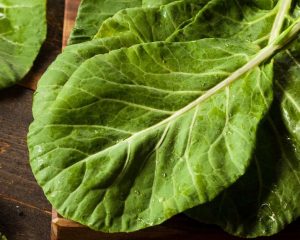 Collard Greens – Collard greens are leafy greens with a slightly bitter, earthy flavor and hearty texture. They are rich in vitamins A, C, and K, calcium, fiber, and antioxidants, which support bone health, immune function, and digestion. Collard greens are often cooked by sautéing, steaming, or simmering in soups and stews, and they’re popular in Southern and African cuisines. Have you used your collard greens to make “lettuce” wraps yet? They hold together better so they are a great substitute. To store, keep collard greens in the refrigerator, wrapped in a damp paper towel inside a plastic bag, where they can stay fresh for up to a week. For longer storage, blanch and freeze them or make green cubes to store for later use.
Collard Greens – Collard greens are leafy greens with a slightly bitter, earthy flavor and hearty texture. They are rich in vitamins A, C, and K, calcium, fiber, and antioxidants, which support bone health, immune function, and digestion. Collard greens are often cooked by sautéing, steaming, or simmering in soups and stews, and they’re popular in Southern and African cuisines. Have you used your collard greens to make “lettuce” wraps yet? They hold together better so they are a great substitute. To store, keep collard greens in the refrigerator, wrapped in a damp paper towel inside a plastic bag, where they can stay fresh for up to a week. For longer storage, blanch and freeze them or make green cubes to store for later use.
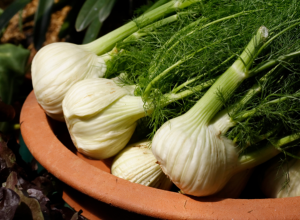 Fennel Bulb – A member of the carrot family, fennel is known for its sweet, anise-like flavor. It is rich in vitamin C, potassium, and manganese. The bulbs can be thinly sliced and added to salads, sautéed, roasted, or grilled. The stalks can be used in soups and stews, and the fronds can be used as an herb-like garnish. Store fennel bulbs in a plastic bag in the crisper drawer, where they can keep fresh for up to a week. If the fronds are still attached, trim them and store them separately wrapped in a damp paper towel inside a plastic bag. For longer storage, fennel bulbs can be blanched and frozen.
Fennel Bulb – A member of the carrot family, fennel is known for its sweet, anise-like flavor. It is rich in vitamin C, potassium, and manganese. The bulbs can be thinly sliced and added to salads, sautéed, roasted, or grilled. The stalks can be used in soups and stews, and the fronds can be used as an herb-like garnish. Store fennel bulbs in a plastic bag in the crisper drawer, where they can keep fresh for up to a week. If the fronds are still attached, trim them and store them separately wrapped in a damp paper towel inside a plastic bag. For longer storage, fennel bulbs can be blanched and frozen.
 Ginger – Ginger is a flavorful root widely used as a spice and natural remedy. It has a warm, slightly spicy taste and is rich in bioactive compounds like gingerol, which has anti-inflammatory and antioxidant properties. Ginger aids digestion, relieves nausea, and supports immune health. It is versatile in cooking and used in teas, curries, stir-fries, baked goods, and beverages. Store fresh ginger in a cool, dry place for short-term use or in the refrigerator in a paper towel or airtight bag for extended freshness. For long-term storage, freeze peeled or sliced ginger.
Ginger – Ginger is a flavorful root widely used as a spice and natural remedy. It has a warm, slightly spicy taste and is rich in bioactive compounds like gingerol, which has anti-inflammatory and antioxidant properties. Ginger aids digestion, relieves nausea, and supports immune health. It is versatile in cooking and used in teas, curries, stir-fries, baked goods, and beverages. Store fresh ginger in a cool, dry place for short-term use or in the refrigerator in a paper towel or airtight bag for extended freshness. For long-term storage, freeze peeled or sliced ginger.
Freeze your fresh ginger for longer storage: Peel and slice or grate the ginger. Freeze in an airtight container or ice cube tray. You can also freeze the whole unpeeled root in a freezer bag. Grate or slice directly from frozen as needed.
 Green Onions – Green onions, also known as scallions, have a mild, slightly sweet onion flavor and are packed with vitamins A and K. They are often used raw in salads, salsas, and garnishes but also add depth to stir-fries, soups, and omelets. Their green tops and white bulbs are both edible, making them a versatile ingredient. Store in the refrigerator, wrapped in a damp paper towel inside a bag, or stand them in a jar of water to keep them fresh longer.
Green Onions – Green onions, also known as scallions, have a mild, slightly sweet onion flavor and are packed with vitamins A and K. They are often used raw in salads, salsas, and garnishes but also add depth to stir-fries, soups, and omelets. Their green tops and white bulbs are both edible, making them a versatile ingredient. Store in the refrigerator, wrapped in a damp paper towel inside a bag, or stand them in a jar of water to keep them fresh longer.
 Jerusalem Artichoke – Jerusalem artichokes, or sunchokes, are nutty, slightly sweet tubers loaded with iron, potassium, and inulin, a fiber that supports digestion. They can be roasted, added to soups or stews, eaten raw in salads, or mashed as a potato substitute. Store them unwashed in a cool, dark place or in a paper bag in the fridge, where they can last up to 2–3 weeks.
Jerusalem Artichoke – Jerusalem artichokes, or sunchokes, are nutty, slightly sweet tubers loaded with iron, potassium, and inulin, a fiber that supports digestion. They can be roasted, added to soups or stews, eaten raw in salads, or mashed as a potato substitute. Store them unwashed in a cool, dark place or in a paper bag in the fridge, where they can last up to 2–3 weeks.
Fun Facts: Despite the name, Jerusalem artichokes are not related to artichokes—they’re actually a type of sunflower root! They are also known as sunchokes. They’re sometimes called earth apples or sunroot because they’re the edible tubers of a type of sunflower.
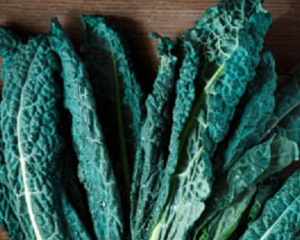 Kale, Lacinato – Lacinato kale, also known as Tuscan or dinosaur kale, is a nutrient-dense leafy green rich in vitamins A, C, and K, as well as calcium, iron, and antioxidants. Its dark green, bumpy leaves have a slightly sweeter flavor compared to other kales, making it ideal for salads, soups, stir-fries, and smoothies. It’s particularly delicious when sautéed with garlic or massaged with lemon juice for raw dishes. To store, place unwashed leaves in a plastic bag or container in the refrigerator’s crisper drawer, where they’ll stay fresh for 5 to 7 days.
Kale, Lacinato – Lacinato kale, also known as Tuscan or dinosaur kale, is a nutrient-dense leafy green rich in vitamins A, C, and K, as well as calcium, iron, and antioxidants. Its dark green, bumpy leaves have a slightly sweeter flavor compared to other kales, making it ideal for salads, soups, stir-fries, and smoothies. It’s particularly delicious when sautéed with garlic or massaged with lemon juice for raw dishes. To store, place unwashed leaves in a plastic bag or container in the refrigerator’s crisper drawer, where they’ll stay fresh for 5 to 7 days.
Fun fact: NASA has studied kale as a potential crop for space missions because of its high nutrient density. Per calorie, kale has more iron than beef and more calcium than milk. And one cup of raw kale has more vitamin C than a whole orange. (But don’t stop eating those other nutrient-packed foods!)

Lettuce, Loose Leaf – Leaf lettuce, known for its loose, leafy structure and mild, slightly sweet flavor, comes in green and red varieties. It is a low-calorie vegetable packed with vitamins A, C, and K, as well as folate and fiber, making it a nutritious choice for salads and wraps. Its tender leaves are best used raw in salads, sandwiches, or as a garnish. Store leaf lettuce in the refrigerator, loosely wrapped in a damp paper towel inside a plastic bag or container, and use it within a week to maintain freshness and crispness.
Mushroom Varieties
Store mushrooms in a paper bag or breathable container in the refrigerator, avoiding moisture buildup, and only wash them right before use to maintain freshness.
Mushrooms are super versatile in the kitchen. Here are 10 Things You Should Do With Mushrooms.
This roundup of 20 Mushroom Recipes has you covered with meal ideas for breakfast, lunch, or dinner.
Mushroom, Portobello & Cremini – Portobello mushrooms are mature versions of cremini mushrooms, offering a meaty texture and rich, earthy flavor. Cremini, also known as “baby bellas,” are younger, smaller, and have a firmer texture with a milder taste. Both are low in calories, fat-free, cholesterol-free, and provide B vitamins, selenium, potassium, and antioxidants. Portobellos are ideal for grilling, roasting, or as a meat substitute in burgers, sandwiches, or stuffed recipes. Creminis are great for sautéing, adding to soups, stir-fries, pasta dishes, or as pizza and salad toppings.
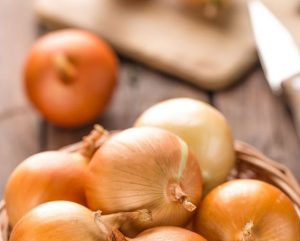
Onion, Yellow – Yellow onions are a popular, versatile vegetable with golden-brown skin and a strong, savory flavor that mellows and sweetens when cooked. Rich in antioxidants, vitamin C, and fiber, yellow onions support immune health, digestion, and overall cellular health. They’re a staple in many cuisines, perfect for sautéing, caramelizing, roasting, and adding depth to soups, stews, and sauces. To store, keep unpeeled yellow onions in a cool, dry, well-ventilated place, away from potatoes, where they can last up to a month; once peeled or cut, store them in an airtight container in the refrigerator for up to a week.
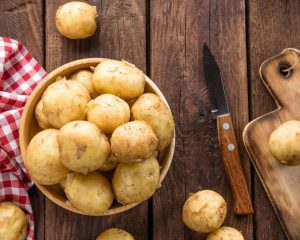 Potato, Yellow – Also known as Yukon Gold or gold potatoes, yellow potatoes have smooth, thin, yellowish skin and creamy, buttery-flavored flesh. They are slightly waxy, making them versatile in cooking. Yellow potatoes are a good source of vitamin C, potassium, and fiber and are low in calories and fat. Their creamy texture makes them ideal for mashing, roasting, grilling, and boiling. They are also excellent in gratins and salads because they hold shape during cooking. Store yellow potatoes in a cool, dark, and well-ventilated place for several weeks, avoiding refrigeration as it can alter their texture and flavor.
Potato, Yellow – Also known as Yukon Gold or gold potatoes, yellow potatoes have smooth, thin, yellowish skin and creamy, buttery-flavored flesh. They are slightly waxy, making them versatile in cooking. Yellow potatoes are a good source of vitamin C, potassium, and fiber and are low in calories and fat. Their creamy texture makes them ideal for mashing, roasting, grilling, and boiling. They are also excellent in gratins and salads because they hold shape during cooking. Store yellow potatoes in a cool, dark, and well-ventilated place for several weeks, avoiding refrigeration as it can alter their texture and flavor.
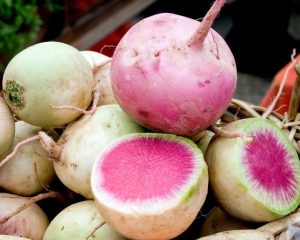 Radish, Watermelon – Watermelon radish is a striking root vegetable with a mild, slightly sweet flavor and a crisp texture. Its pale green skin hides a vibrant pink interior, resembling a watermelon. Rich in vitamin C, potassium, and antioxidants, it supports immune health and reduces inflammation. Watermelon radishes can be enjoyed raw in salads, sliced thinly for garnishes, pickled, or roasted for a milder flavor. Store unwashed watermelon radishes in a perforated plastic bag in the refrigerator, where they can stay fresh for up to two weeks. Wash and trim just before using.
Radish, Watermelon – Watermelon radish is a striking root vegetable with a mild, slightly sweet flavor and a crisp texture. Its pale green skin hides a vibrant pink interior, resembling a watermelon. Rich in vitamin C, potassium, and antioxidants, it supports immune health and reduces inflammation. Watermelon radishes can be enjoyed raw in salads, sliced thinly for garnishes, pickled, or roasted for a milder flavor. Store unwashed watermelon radishes in a perforated plastic bag in the refrigerator, where they can stay fresh for up to two weeks. Wash and trim just before using.
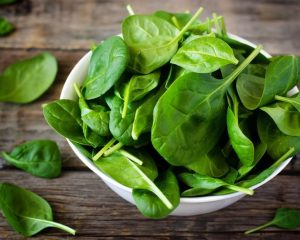 Spinach – Spinach is a nutrient-rich leafy green vegetable packed with vitamins A, C, K, and folate, along with minerals like iron and magnesium. Low in calories and high in antioxidants, it supports eye health, bone strength, and immune function. Spinach is versatile and can be enjoyed raw in salads, blended into smoothies, or cooked in soups, pasta, and omelets. To store, keep it dry in a perforated plastic bag in the fridge’s crisper drawer, and wash only before use. Properly stored, it stays fresh for 5-7 days.
Spinach – Spinach is a nutrient-rich leafy green vegetable packed with vitamins A, C, K, and folate, along with minerals like iron and magnesium. Low in calories and high in antioxidants, it supports eye health, bone strength, and immune function. Spinach is versatile and can be enjoyed raw in salads, blended into smoothies, or cooked in soups, pasta, and omelets. To store, keep it dry in a perforated plastic bag in the fridge’s crisper drawer, and wash only before use. Properly stored, it stays fresh for 5-7 days.
 Sweet Potato – Sweet potatoes are a nutritious root vegetable known for their naturally sweet flavor and vibrant orange flesh, though they also come in other colors like purple and white. They are rich in vitamins A (as beta-carotene), C, and B6, as well as dietary fiber, potassium, and antioxidants. These nutrients support eye health, boost immunity, and promote digestive health. Sweet potatoes are versatile in cooking and can be baked, roasted, mashed, or used in soups and stews. They can also be enjoyed in both savory and sweet dishes. Store sweet potatoes in a cool, dark, well-ventilated place for several weeks, avoiding refrigeration as it can affect their texture and flavor.
Sweet Potato – Sweet potatoes are a nutritious root vegetable known for their naturally sweet flavor and vibrant orange flesh, though they also come in other colors like purple and white. They are rich in vitamins A (as beta-carotene), C, and B6, as well as dietary fiber, potassium, and antioxidants. These nutrients support eye health, boost immunity, and promote digestive health. Sweet potatoes are versatile in cooking and can be baked, roasted, mashed, or used in soups and stews. They can also be enjoyed in both savory and sweet dishes. Store sweet potatoes in a cool, dark, well-ventilated place for several weeks, avoiding refrigeration as it can affect their texture and flavor.
 Sweet Potato, Fingerling – Sweet potato fingerlings are small, slender sweet potatoes with thin, edible skin and a naturally sweet, creamy texture. They are rich in fiber, beta-carotene, and vitamin C, promoting digestive and immune health. Roast, sauté, or air-fry them whole for a crispy skin and tender interior, or slice them into fries or hash. Store in a cool, dry place away from light, but avoid refrigeration as it can affect their texture.
Sweet Potato, Fingerling – Sweet potato fingerlings are small, slender sweet potatoes with thin, edible skin and a naturally sweet, creamy texture. They are rich in fiber, beta-carotene, and vitamin C, promoting digestive and immune health. Roast, sauté, or air-fry them whole for a crispy skin and tender interior, or slice them into fries or hash. Store in a cool, dry place away from light, but avoid refrigeration as it can affect their texture.
 Swiss Chard (baby) – Milder and more tender than mature Swiss chard, baby chard is often used raw in salads, wraps, or grain bowls. While still rich in vitamins A, C, and K, it may have slightly less fiber than its fully grown counterpart. Store in a sealed container with a dry paper towel in the fridge and use within 3–5 days for the best freshness.
Swiss Chard (baby) – Milder and more tender than mature Swiss chard, baby chard is often used raw in salads, wraps, or grain bowls. While still rich in vitamins A, C, and K, it may have slightly less fiber than its fully grown counterpart. Store in a sealed container with a dry paper towel in the fridge and use within 3–5 days for the best freshness.
Fun fact: Chard is in the chenopod family which includes beets, spinach, and quinoa.
Don’t Forget: Online shopping opens Friday at 1 PM! 🛒 Stock your kitchen with these clean, nourishing ingredients to fuel your family with nutrient-dense meals. Be sure to grab your favorite staples and try something new for vibrant health this winter.
Don’t wait to join…
Veggie E-Books
Download these collections of tips and recipes for each veggie. You’ll use these as a reference throughout the season.
Arugula E-Book
Beets E-Book
Carrots E-Book
Collard Greens E-Book
Kale E-Book
Lettuce E-Book
Mushrooms E-Book
Onions E-Book
Potatoes E-Book
Radish E-Book
Scallion/Green Onion E-Book
Spinach E-Book
Swiss Chard E-Book
~~~~~
Farm News and Events
We’ll keep farming for you!
Reuben and Tessa DeMaster
Willow Haven Farm


